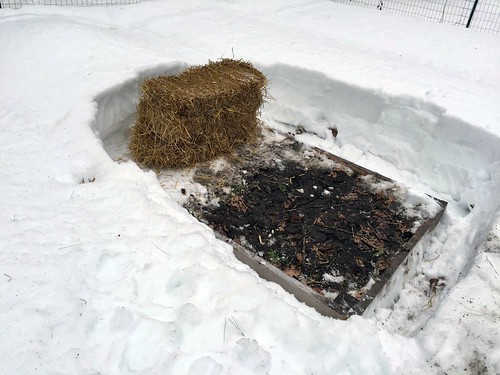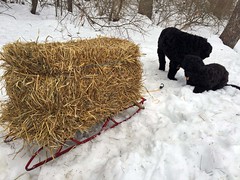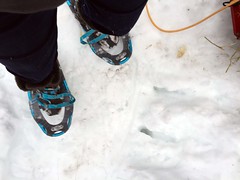


What I read is that I need to water my bale for about 3 days. This starts decomposition inside the bale and it gets hot. I can either wait several weeks, or speed up decomposition by adding a nitrogen source every few days and continuing watering. With the nitrogen added, after 10 days the bale will be ready for planting seeds.
Nice sites I've found include:
no-dig-vegetablegarden.com
HGTVGardens.com
But I have to admit that I don't understand several things. Why is the heat of the initial decomposition a problem? It's freezing cold outside so how can it get too hot now? Its seems heat would be good for the plants now.
In addition, I'm thinking that the peas I will plant can fix their own nitrogen, well with help from the Rhizobium bacterial inoculant I'll add when I plant them, so why do I need to worry about adding nitrogen to the hay bale?
I want to understand exactly what's going on in the conditioning process. Explanations I find generally seem vague and the process seems almost magical.
This site seems to get at a better explanation: Oklahoma Coop Ext
"...if seed or seedlings are planted into a fresh bale, microbes in the bale will use any nutrients present to breakdown (or decompose) the straw depriving the growing seedlings of nutrients such as nitrogen, phosphorus and other essential elements"
Ah, so the decomposition process is doing more than producing heat, it's tying up phosphorus and other nutrients that pea plants will need. Fortunately it only lasts a short time in the bale. Decomposition of other materials takes years and I know can be a problem if it takes place in soils where plants are trying to grow.
Well that makes more sense to me. I'll start to add nitrogen. Good organic nitrogen sources are blood meal and fish emulsion. I have a nice fish emulsion. I'll try to get down to the garden to add this today, and I'll see if its really hot inside the bale. Fortunately we're getting nice rain soon, so I don't need to carry water.
4 comments:
i'm very interested to follow along and see how this works - i've toyed with the idea of trying this method, but confess that i haven't done any reading about. lovely to see all your seedlings starting!
I just went down to the garden and checked on the bale. It's completely dry inside and not at all warm. I guess the rain we had wasn't enough. I read that I am suppose to water it everyday. I guess that's true.
I added some fish emulsion anyway. It'll rain for the next two days. Now I'm thinking maybe I shouldn't have added the fertilizer as the bale is supposed to start cooking before the fertilizer is added.
I've been reading up on the process as well - as you say, sometimes the instructions are vague. And then there is the fertilizer - the amounts suggested for organic fertilizer are huge - several cups a day over several days for each bale - that would be a mighty expensive proposition. I purchased several bales in the fall & have left them out all winter - it will be interesting to see if this is enough "conditioning" for them come planting time.
I think that sounds perfect Margaret. I've read that the fertilizer addition is just to speed up the process, which is apparently complete in a few weeks without fertilizer added. They say just stick your hand inside the bale and make sure its not hot.
Post a Comment